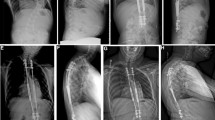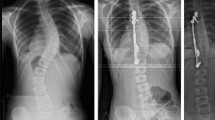Abstract
Purpose
Severe, early-onset spinal deformity is common in patients with skeletal dysplasia. These deformities often present at young ages and are associated with significant pulmonary dysfunction. The objective of this study is to verify the effectiveness of growth-friendly spinal instrumentation systems in promoting growth in patients with skeletal dysplasia and early-onset kyphoscoliosis.
Methods
A retrospective, multicenter comparative cohort study was performed. Twenty-three patients identified to have a skeletal dysplasia (SKD) were evaluated for diagnosis, age at treatment, gender, and type of growing rod construct (spine vs. rib constructs). Patients were matched by age and construct type with similarly treated patients with early-onset scoliosis (CON) without skeletal dysplasia. Radiographic parameters including maximum coronal and sagittal Cobb angle with levels, T1–S1 height, and T1–T12 height were measured.
Results
T1–T12 (12.8 vs. 15.2 cm, p = .01) and T1–S1 (21.2 vs. 24.5 cm, p = .05) heights were significantly shorter for the SKD group at implantation, and kyphosis tended to be more severe in children with SKD (p = .80 and .07, respectively). Kyphosis did not improve with treatment. Scoliosis improved (p < .01), and ΔT1–T12 and ΔT1–S1 significantly increased in both groups (p < .01). Complication rates were similar between the two groups; however, patients with SKD had more intraoperative monitoring changes and hardware failures (p < .005).
Conclusion
Although patients with SKD start with shorter spine lengths, gains in spine length appear to be comparable to other forms of EOS. Neuromonitoring changes and implant failures are more common in the SKD group.
Significance
The effectiveness of growth-friendly techniques in promoting growth in early-onset spinal deformities in patients with skeletal dysplasia has not been previously studied. We report the first comprehensive review of this topic. Growth-friendly techniques are an appropriate treatment option in this patient population.
Similar content being viewed by others
References
Bethem D, Winter RB, Lutter L, et al. Spinal disorders of dwarfism. Review of the literature and report of eighty cases. J Bone Joint Surg Am 1981;63:1412–25.
Tolo VT. Spinal deformity in short-stature syndromes. Instr Course Lect 1990;39:399–405.
Jalanko T, Remes V, Peltonen J, et al. Treatment of spinal deformities in patients with diastrophic dysplasia: a long-term, population based, retrospective outcome study. Spine 2009;34: 2151–7.
Song D, Maher CO. Spinal disorders associated with skeletal dysplasias and syndromes. Neurosurg Clin N Am 2007;18:499–514.
Bethem D, Winter RB, Lutter L. Disorders of the spine in diastrophic dwarfism. J Bone Joint Surg Am 1980;62:529–36.
Mason DE, Sanders JO, MacKenzie WG, et al. Spinal deformity in chondrodysplasia punctata. Spine 2002;27:1995–2002.
Thomas S, Winter RB, Lonstein JE. The treatment of progressive kyphoscoliosis in camptomelic dysplasia. Spine 1997;22:1330–7.
Matsuyama Y, Winter RB, Lonstein JE. The spine in diastrophic dysplasia: the surgical arthrodesis of thoracic and lumbar deformities in 21 patients. Spine 1999;24:2325–31.
Karatas AF, Dede O, Rogers K, et al. Growth-sparing spinal instrumentation in skeletal dysplasia. Spine 2013;38:E1517–26.
Author information
Authors and Affiliations
Consortia
Corresponding author
Additional information
IRB approval: This study was reviewed and approved by Seattle Children’s Research Institute IRB ID# PIROSTUDY14864.
Author disclosures: KKW (none), VB (none), SAS (none), GJR (none), WFK III (none), WGM (none), Children’s Spine Study Group, Growing Spine Study Group.
Rights and permissions
About this article
Cite this article
White, K.K., Bompadre, V., Shah, S.A. et al. Early-Onset Spinal Deformity in Skeletal Dysplasias: A Multicenter Study of Growth-Friendly Systems. Spine Deform 6, 478–482 (2018). https://doi.org/10.1016/j.jspd.2018.01.002
Received:
Accepted:
Published:
Issue Date:
DOI: https://doi.org/10.1016/j.jspd.2018.01.002




